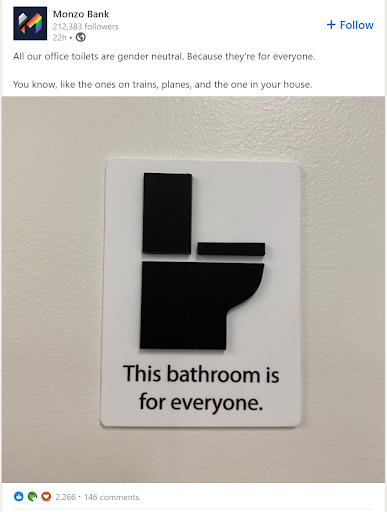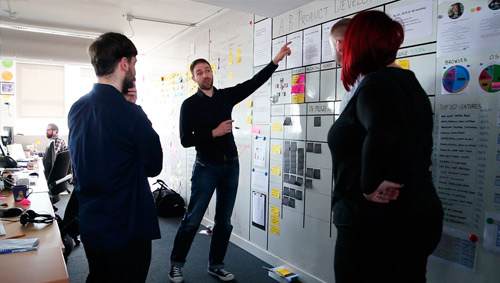When Pepsi asked customers to print their own labels to stop the disappointment you get from opening upcycled ice cream tubs, it seemed a bit leftfield.
In actual fact, it was completely on-brand.
Because the company’s mission is to “create more smiles…”, while its vision is all about ”...winning with purpose”; exactly what this lighthearted and eco-friendly campaign set out to do.
According to Campaign Asia, this stunt achieved around 30% more organic engagement than the average post with a 300% increase in viewing time - it was a total success.
And it’s evidence that great branding goes way beyond logos; now more than ever, it’s what’s inside that counts.
With that in mind, here are our four simple steps to great branding...
- Discover your purpose
- Define your character
- Tell your story
- Find your voice & visualise your identity
Step 1: Discover your purpose
Essentially, brand purpose is why you exist.
And there was a time when finding it was as simple as doing the competitor research to establish a unique value proposition (UVP); your individual essence - the ‘heart and soul’ of the brand.
But it’s safe to say that in 2021, consumers are expecting a bit more.
In fact, studies show that 63% of consumers prefer to purchase from purpose-driven brands.
So in order to create a more emotional and meaningful connection with audiences, brands need to not only stay true to themselves and why they started; they need to demonstrate how a product is going to help the customer fulfil their own purpose, too.
Simple enough when your heart’s in the right place, surely?
Well, not exactly. For example, it’s not enough to commit to planting 100 trees a month out of the blue. Your actions have got to complement your character; otherwise, things can feel a little forced.
Sure there are purpose-driven brands like the Body Shop where this approach feels like a natural fit; the company is committed to helping 40,000 vulnerable people around the world regenerate 75 million square metres of natural habitat - and it works with the brand’s sustainable product offering.
But for other brands, the glove doesn’t always fit quite so comfortably; instead, they have to work a little harder.
Monzo is a community bank that’s purpose is to be inclusive to everyone. So all of its actions - be it internally or externally - reflect this.

And take Evernote for example. Its purpose is to “...help people focus on what matters most”. From the logo depicting an elephant that never forgets, to discounts that help nonprofits innovate and collaborate, this brand’s found a purpose that makes sense for its product.
But brands can’t live on purpose alone. To stand out and truly have a chance of resonating with audiences, they need some personality too.

Never miss an update from us.
Get monthly does of brand, marketing and tech delivered directly to your inbox!
Step 2: Define your character
Carl Jung, one of the forefathers of psychoanalysis, suggested that archetypes are part of our collective unconscious - a myth-making fabric that’s in all of us.
But what does this have to do with brands, you ask?
Well, if his theory is correct, it means that archetypes don’t just exist within stories and characters, they exist within all groups.
Including brands.
In brand theory, there are twelve archetypes; characters defined by traits that explain what they stand for and what motivates their actions. They’re a way of presenting a brand – its symbology, values, behaviours, messages – as a persona. They are:
- The Innocent - imagine the joyous advertising campaigns and comms of Coca-Cola
- The Rebel - convention-breaking agents of change, e.g. Oatly or Harley Davidson
- The Lover - intimate, relationship-builders such as Magnum and Lindt
- The Jester - lighthearted, mischievous and irreverent brands like Paddy Power
- The Sage - trusted sources of truth and information - think BBC and Google
- The Ruler - brands that have a product that speaks for itself, e.g. Mercedes Benz
- The Explorer - restless, adventurers such as Jeep, Airbnb and Red Bull
- The Magician - imaginative visionaries like Apple and Disney
- The Hero - brands that look to inspire others and make a positive impact, e.g. Nike
- The Caregiver - selfless nurturers such as Campbell’s Soup and Pampers
- The Creator - those that live to foster the imagination, e.g. Lego or Minecraft
- The Regular Guy/Girl - down to Earth types that have a common touch, e.g. Amazon or eBay
“Choosing the right archetype can help you build a relationship with your audience, giving them familiar characteristics they can connect with. It strengthens your brand positioning and gives people the shorthand they need to understand what your brand stands for,” says Laura Wood in ‘12 brand archetypes: characters in your brand’s story' for The Drum.
Consequently, it also makes it easier for brands to lock down their core values. Just look at these as character traits that help the brand feel more well-rounded. Pick four or five, tops, to complete the picture.
But what are characters without a story?
Step 3: Tell your story
“When you boil down the Olympics, it comes down to the stories that differentiate one athlete from another. They’re like campfire tales about parenting and perseverance, hard work and overcoming adversity,” said Nancy Marshall in ‘What the Tokyo Olympics taught us about personal branding’ for Forbes.
But business brands are no different.
In The Seven Basic Plots: Why We Tell Stories, Christopher Booker argued that every story we read or watch is a variation of an age-old narrative. And because these plots are so ingrained in our makeup, told and retold over generations of storytelling, they’re also a powerful way for brands to engage their customers. The Seven Basic Plots are:
- Overcoming the Monster - usually a good fit for challenger brands like BrewDog
- The Quest - think LinkedIn and its journey to create universal, economic opportunity
- Voyage and Return - brands offering a temporary escape, e.g. Expedia or Airbnb
- Comedy - a rare choice, but Card Against Humanity springs to mind here
- Tragedy - a good example is Hinge: the dating app “Designed to be Deleted”
- Rags to Riches - a classic entrepreneurial tale, e.g. Innocent
- Rebirth - a great recent example is Carlsberg changing its story from “piss to pilsner”
We’ve gone into more detail about how these work in our post ‘From rags to rebirths - seven basic plots in modern brands’.
But it’s not just a theory, there’s some actual science behind it, too: research shows that stories activate parts of the brain that other forms of communication don't. Essentially, engaging with these tales springs our sensory cortex into action.
And now you’ve got your story straight, it’s time to bring it all to life…
Step 4: Find your voice & visualise your identity
Brand tone of voice and visual identity really do go and hand-in-hand. If executed correctly, they can feel completely harmonious alongside each other.
But there’s no content-led or design-first here; copywriters and designers have to work together to get it right.
This involves both parties being involved in the branding process - from purpose to plot. Because great branding is both creative and consistent, so you need to be aligned at every stage.
Together your team can create a brand bible where both tone of voice elements and visual aspects complement each other instead of jarring. A comprehensive guide should include:
- Brand purpose - what’s your mission statement and vision for the future?
- Values - explain your core values and demonstrate them in action
- Story and archetype - set the scene and paint a picture of who you are
- Tone of voice - tone formality, the complexity of sentences, whether you use contractions, active vs. passive voice, etc. You could also include some sample content; how this might look on the website, blog or on social. We’ve got some general copywriting pointers that’ll help you get started here.
Interested in copywriting for tech? We've got a podcast about that
-
Visual identity - include all the different variations of your logo and usage recommendations, the visual language, e.g. iconography, colour schemes, your chosen typography and font family and any brand photography
These brand guidelines can become a set of rules for your organisation to live and die by. But just make sure everyone’s using that right version, though.
Looking to find an easier way to get the team singing from the same hymn sheet? Get in touch and find out how digital asset management could keep your digital ducks in a row.



